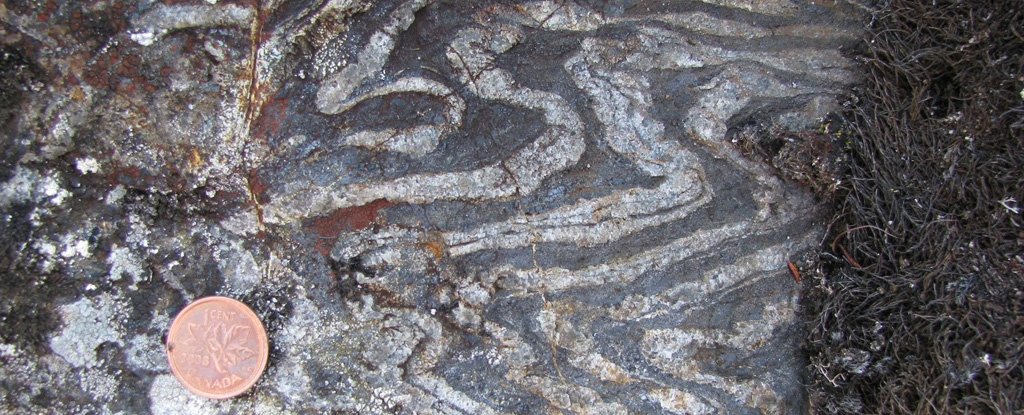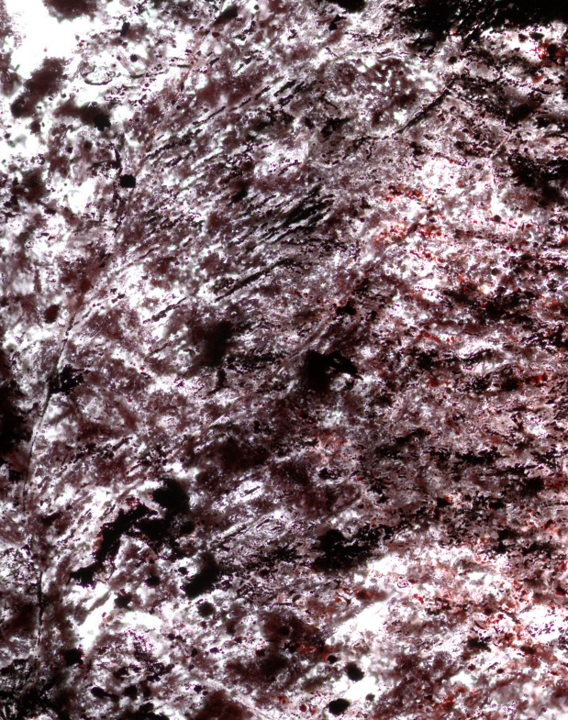All life on Earth probably arose out of one flash in Earth’s initial history. Some time later, it broadened, diverging into heredities that assisted it with making due.
Precisely when these minutes happened has been a disputed matter in mainstream researchers, however new exploration proposes the two stages might have occurred sooner than we recently suspected.

Detailed view of an iron formation with wavy bands. (D. Papineau)
The review, drove by University College London analysts expands on proof of assorted microbial life inside a clench hand estimated piece of rock from Quebec in Canada, dated to around 3.75 billion to 4.28 billion years.
In 2017, the specialists who found it estimated that designs in the stone – small fibers, handles, and cylinders – had been left by old microscopic organisms.
Yet, not every person was persuaded that these designs – which would push the date for the principal indications of something going on under the surface on Earth back by somewhere around 300 million years – were organic in beginning.
Pink stone with dim dark streaks and white strings going through
The fibers seen here are the stem-like designs demonstrating most established known fossils.(D. Papineau)
Nonetheless, after additional broad investigation of the stone, the group found a much bigger and more perplexing design than those which were recently distinguished. Inside the stone was a stem-like design with equal branches on one side that are almost a centimeter long, as well as many misshaped circles, or ellipsoids, close by the cylinders and fibers.
“This implies life might have started just 300 million years after Earth framed. In land terms, this is speedy – around one twirl of the Sun around the cosmic system,” says lead creator of the review, geochemist Dominic Papineau from UCL.
/https://tf-cmsv2-smithsonianmag-media.s3.amazonaws.com/filer/85/ce/85cef5ae-72eb-4a13-bd54-d71235a8afc5/motility.jpg)
Suspected traces of a tunneling organism, 2.1 billion years ago.
PUSHING THE BOUNDARIES
A few 3.8 billion quite a while back, the first lifeforms arose on Earth, and they were single-celled living beings, like microorganisms. Then, around 541 million a long time back, mind boggling, multicellular life showed up during a transformative occasion known as the Cambrian Explosion. A lot of what we are familiar this somewhat brief period in history is gathered from fossil proof. Presently, the disclosure of abnormal fossils in sedimentary rocks in focal India might push this developmental second back by 400 million years.
“The ‘hour of apparent life’ appears to have started a whole lot sooner than we naturally suspected.”
Therese Sallstedt from the Swedish Museum of Natural History has found fossils that seem, by all accounts, to be the earliest proof of vegetation. Radiometric dating puts them at generally 1.6 billion years of age, which would make them the most seasoned proof of red green growth at any point found.
“I had seen something almost identical a tad before in other flimsy areas … yet the ‘aha second’ was the point at which I found this specific example [and] saw these settlements of green growth,” said Sallstedt, addressing The Independent. “That is the point at which I understood, goodness, this should be further developed than microorganisms.”

The filaments seen here are the stem-like structures indicating oldest known fossils.(D. Papineau)
Picture credit: Stefan Bengston
Sallstedt’s group exposed the fossils to an imaging strategy called X-beam tomographic microscopy. This permitted them to distinguish consistently repeating platelets in every one of the cells. They imagine that these might have been essential for the creature’s chloroplasts, the cell structure where photosynthesis happens. Cell wellsprings, fiber structures normal in red green growth, were additionally recognized.
COMPLEX LIFE IS COMPLEX
The development of perplexing life is as yet probably the best secret of science. We realize it needed to have occurred at a specific second when the circumstances were perfect. It’s indistinct, be that as it may, why basic life developed at a prior stage however complex life took such a long time to follow. Whenever demonstrated to really be from crown bunch red green growth, these new fossils will challenge our presumptions about when this advancement of intricate life truly happened.
*4* Complex Life on Earth May Have Started 400 Million Years Earlier
Snap TO VIEW FULL INFOGRAPHIC
“These fossils pre-date the beforehand earliest acknowledged red green growth by around 400 million years, recommending that eukaryotes might have a more drawn out history than ordinarily accepted,” Sallstedt said of the group’s examination, which was distributed in the diary PLOS Biology. Already, the most established known examples of red green growth were believed to be 1.2 billion years of age.
“The ‘hour of noticeable life’ appears to have started a whole lot sooner than we naturally suspected,” said Stefan Bengtson, an individual from the exploration group. Notwithstanding, without DNA proof to help the group’s affirmations, demonstrating anything is troublesome. “You can’t be 100% certain about material this old, as there is no DNA remaining, yet the characters concur very well with the morphology and construction of red green growth,” made sense of Bengtson.
Thus, while it may not be imaginable to say authoritatively that these fossils are from eukaryotic red green growth, the presence of elements generally connected with multi-cell creatures unquestionably makes it appear as though they are. Thusly, that compels us to reevaluate when complex life really started. Tests of comparable fossils could ultimately be found somewhere else, so further examination is most certainly justified.
The vital inquiry for Papineau and his partners was whether it was feasible for these designs to have shaped through compound responses not connected with living things.
As indicated by the paper, a portion of the more modest constructions might have possibly been the result of abiotic responses, be that as it may, the recently recognized ‘tree-like’ stem is probably organic in beginning, as no design like it, made through substance responses alone, has been found previously.
Notwithstanding the constructions, specialists recognized mineralized synthetic substances in the stone that might have been results of various sorts of metabolic cycles.
The synthetic compounds are predictable with energy-extraction processes in the microscopic organisms that would have involved iron and sulfur; contingent upon the translation of substance marks, there might be traces of a variant of photosynthesis.
This tracking down focuses to the likelihood that the early Earth – just a short time after its arrangement – was possessed by a variety of microbial life.
The stone was dissected through a mix of optical perceptions through Raman magnifying instruments (which utilize light dissipating to decide substance structures), and carefully reproducing areas of the stone with a supercomputer that handled a huge number of pictures from two high-goal imaging strategies.
The piece of rock being referred to was gathered by Papineau in 2008 from Quebec’s Nuvvuagittuq Supracrustal Belt (NSB), which was once a piece of the ocean bottom. The NSB contains probably the most established sedimentary rocks known on Earth. The fossil-loaded rock was likewise investigated for levels of uncommon Earth components, with scientists observing it did without a doubt have similar levels as other old stone examples, affirming it was all around as old as the encompassing volcanic rocks.
Pinkish red stone with a Canadian quarter put close to it
Dazzling red iron and silica-rich stone which contains rounded and filamentous microfossils. (D. Papineau)
Before this revelation, the earliest fossil proof of life was found in Western Australia, which goes back 3.46 billion years. In any case, comparable dispute exists around whether these fossils were organic in beginning.
Maybe the most thrilling ramifications from this disclosure are how it affects the likely conveyance of life in the Universe. Assuming life had the option to create and advance in the cruel states of the early Earth, then, at that point, it very well might be more normal all through the universe than we suspect.
“This revelation suggests that two or three hundred million years are required for life to develop to a coordinated level on an early stage tenable planet,” express the creators of the paper.
“We consequently infer that such microbial environments could exist on other planetary surfaces where fluid water associated with volcanic rocks, and that these most seasoned microfossils and dubiofossils revealed here from the NSB recommend that extraterrestrial life might be more far and wide than recently suspected.”
The review was distributed in the diary Science Advances.